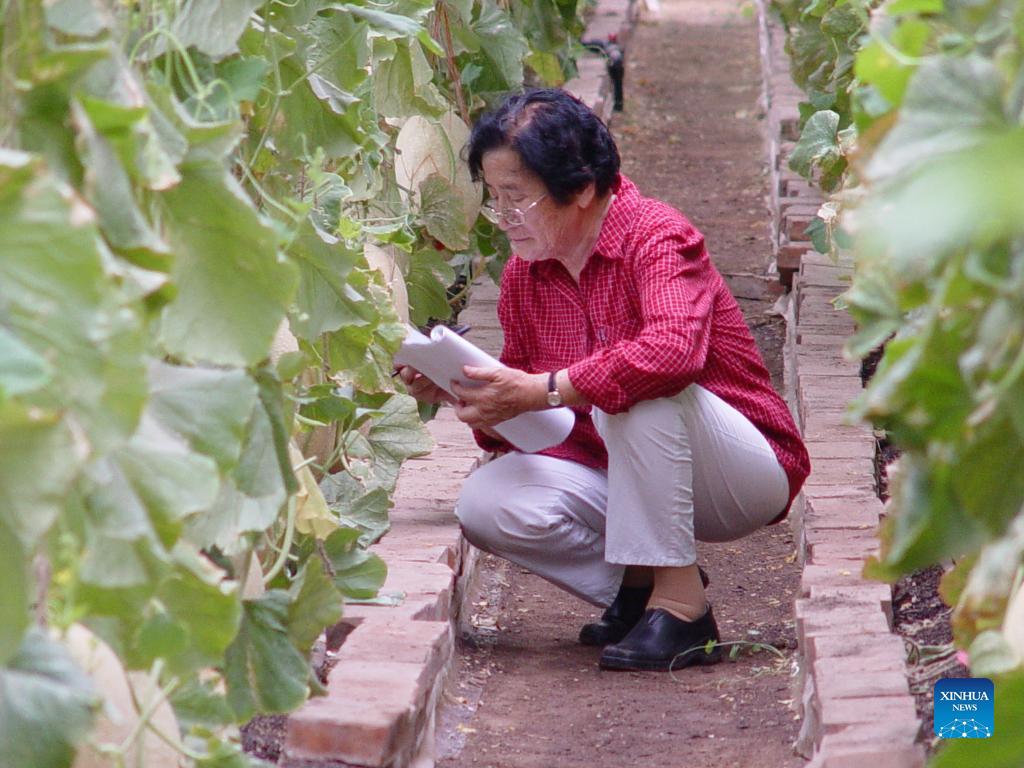Profile: Chinese horticulturist's 60 years of unremitting efforts at melon breeding

This undated scanned photo shows Wu Mingzhu in a field. (Hami Melon Research Center, Xinjiang Academy of Agricultural Sciences/Handout via Xinhua)
URUMQI, Nov. 11 (Xinhua) -- Eleven years after being diagnosed with Alzheimer's disease, 91-year-old Wu Mingzhu sometimes fails to recognize her former colleagues or even her family members who live by her side.
But her memory of the melon varieties she developed while working in northwest China's Xinjiang Uygur Autonomous Region lingers.
"Although my mom had to retire due to the disease, she would tell me that she was going to return to the melon farms in Xinjiang to help pollinate the melons," said Yang Xia, Wu's son.
Wu, an academician with the Chinese Academy of Engineering who is proficient in melon breeding, has made cultivating the fruit a lifelong career through six decades of practice.
Born in central China's Hubei Province, she was admitted to Southwest Agricultural College in Chongqing Municipality majoring in horticulture in the late 1940s.
As a newbie in agriculture, her first practical session at the college was to assemble a hoe and then dig a trench. In the following classes, she learned how to build a hotbed, sow seeds, apply fertilizers and sprinkle water as prerequisites before she could fully master field management.
Under her teachers' guidance, she also went to rural areas to do farm work to help local farmers.
At 21, she wrote in her diary: "The most beautiful thing in life is that everything you create can serve the people."
During the final semester, the students including Wu received letters from their seniors who had worked in Xinjiang. The letter stated that Xinjiang, dubbed as "a land of melons and fruits," was in need of horticulture talents who can help develop the melon industry there. This marked the start of her bond with the region.
After her graduation in 1953, Wu was assigned to work in Chongqing and was later transferred to Wuhan in Hubei Province and thereafter to Beijing. But, she had already set her eyes on her long-awaited goal -- to work in Xinjiang's melon fields and apply the knowledge she had acquired in college.
Wu filed an application after the Xinjiang Uygur Autonomous Region was officially established in 1955, and finally received approval. In the winter of the same year, she boarded a truck with all her belongings and left for Xinjiang's capital Urumqi.
It took her around a fortnight to get there, and after arrival, she realized that things were different from what she had expected -- there were no endless melon fields sprawling across Urumqi.
Instead of feeling sorry for herself, she decided to make most of the opportunity. She conducted thorough research and found that the Shanshan County in Turpan Basin, about 300 km from Urumqi, possessed favorable conditions for melon cultivation. Thus, she requested a transfer to the county.
Though local watermelons and muskmelons tasted sweet and crisp, Wu found that the local farmers mainly relied on traditional farming techniques, and there was still much room for improvement in the yield and quality of melons.
Starting in 1956, Wu and her colleagues met with some 300 production teams to explore germplasm resources in the summer heat of over 40 degrees Celsius. The climate was so unpleasant that the locals complained "even donkeys were reluctant to go out during summer."
Wu ate, lived, and worked with the farmers, learning how to cut wheat stalks, hoe cotton and ride donkey carts from them.
"At that time, there was no scientific research fund, so the usage of seeds, fertilizers, and land were dependent on the support of local farmers. No matter which piece of land I wanted to conduct experiments on, they all agreed," she recalled.
Wu leads a busy life. She experimented with different breeding methods on melons during the day, and read more than 100 documents that recorded 44 melon varieties that they summarized under candle light at night.
However, a well-timed reunion brought her a sigh of relief. In 1957, Wu's boyfriend Yang Qiyou arrived in Xinjiang to support her work. They graduated from the same college, and Yang was a wheat breeding expert. The next year, they got married.
Yang offered his full support to Wu so she could concentrate on her studies. "When he came across useful information in academic journals, he would always note it down for me. He helped me come up with new ideas. When I was incredibly busy, he would help me pollinate and hybridize the melons," Wu recalled.
They spent nearly 30 years together before Yang was diagnosed with stomach cancer and died of the disease in 1986.
The loss hit Wu like a thunderbolt. "I could manage all of the hardships in my life, but the sorrow of losing my husband to cancer was overwhelming," she said.
But when she returned to the melon fields in Xinjiang, she was the same dedicated woman. "Only by accomplishing both of our tasks could I live up to my husband's efforts and the trust of the Xinjiang people," she said.
Since then, Wu worked even harder, shuttling between Xinjiang and south China's Hainan Province, where another melon breeding base was established in 1973.
Wu developed a number of germplasm resources, featuring characteristics like better disease resistance, finer fruit quality, greater adaptability and easily transportable, helping the farmers fatten their wallets.
"Zaojia 8428," a watermelon variety bred by Wu, is fine in texture and crispy in taste. Since the late 1980s, this variety has covered the entire Chinese market.
Industry experts used to believe that it would take eight to 10 years or even longer to cultivate a high-quality variety. However, Wu and her colleagues have developed 29 varieties -- 10 watermelon varieties and 19 muskmelon varieties.
In 2010, at the age of 80, Wu had to leave her job due to Alzheimer's disease. Since then, she has been living in Chongqing with her son.
Fortunately, some have taken the "baton" from Wu and marched ahead.
"As the first chief scientist of China's melon industry, Wu has set an example for us. I hope I will also be able to make some achievements in the field," said Ling Yueming, a post-90s researcher with Hami Melon Research Center, Xinjiang Academy of Agricultural Sciences.

This undated scanned photo shows Wu Mingzhu (L) and her students in a field. (Hami Melon Research Center, Xinjiang Academy of Agricultural Sciences/Handout via Xinhua)
Photos
Related Stories
- Aksu, Hotan in NW China’s Xinjiang shift into the development fast lane
- Xinjiang residents tell stories of regional development, prosperity
- Embassy Spokesperson's Remarks on The Times' Article Which Slanders Xinjiang
- Industrial park in Xinjiang's Kashgar provides jobs for local residents
- Xinjiang experts, scholars reject "forced labor" lies
Copyright © 2021 People's Daily Online. All Rights Reserved.










